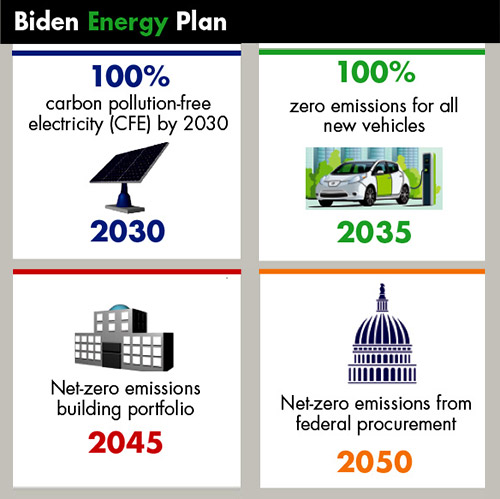- 100-percent carbon pollution-free electricity (CFE) by 2030, at least half of which will be locally supplied
- All new vehicles 100 percent zero emissions by 2035, including 100 percent zero emissions for light-duty vehicles by 2027
- A net-zero emissions building portfolio by 2045, including a 50 percent emissions reduction by 2032
- Net-zero emissions from federal procurement no later than 2050, including incentives for using construction materials with lower embodied emissions
Impacts to Business
These targets are intended to be part of the U.S. contribution to the international Paris Climate Agreement and will have significant impacts to the operations of U.S. businesses.
To ensure a smooth transition to a net-zero business environment, companies should formulate a long-term sustainable energy strategy. By being proactive in this way, organizations will position themselves for regulatory success when they identify and mitigate emission reduction targets and use Internet of Things technologies to monitor, collect, and analyze emissions data and energy consumption. This information is essential for creating a well-defined plan/schedule for implementing periodic net-zero benchmarks to keep these companies on course to meet sustainability goals.
“Many major U.S. companies are already aligning their business strategies with net-zero emissions by 2050 or sooner through corporate initiatives like the Business Ambition for 1.5°C campaign, Climate Pledge, and the SME Climate Hub for small- and medium-sized enterprises,” stated Maria Mendiluce, CEO of the We Mean Business coalition, in Harvard Business Review.
Below are four key impacts for businesses to consider as they wonder how the Biden energy plan will impact their operations:
- Reducing emissions — The federal government will likely issue guidance documents that will help companies determine the best approach for developing a long-term, sustainable climate strategy that monitors, collects, records, and analyzes greenhouse gas emissions and prepares that data for disclosure.
“An energy and sustainability management platform synced with sustainability reporting frameworks can help companies collect their own energy and emissions data and have the ability to utilize and report it as needed,” states EnergyWatch, an energy and sustainability management software provider. To start the process of assessing and managing climate-related risk, “companies can disclose their environmental impacts through CDP or follow the recommendations of the Taskforce on Climate Related Financial Disclosure,” added Mendiluce.
To ensure a smooth transition to a net-zero business environment, companies should formulate a long-term sustainable energy strategy.
- Losing market share — U.S. businesses that do not take this challenge seriously will rapidly fall behind in the net-zero-emissions quest. Not only are they faced with competitive disadvantages, perhaps more important is the risk of disillusioning once-loyal customers, leading to brand erosion and loss of market share. Also, as Biden’s energy policy moves forward, there will be greater pressure exerted on companies to announce and document their sustainability efforts, which will make any careless or lackluster efforts more visible to the public. Consumer opinion matters — after all, a 2019 study showed that 47 percent of U.S. consumers would pay more for a sustainable product, with 35 percent willing to pay 25 percent more for sustainable products.
- Pleasing investors — Companies that rely on capital from outside investors for growth must realize that their sustainability efforts are key to securing larger investments in their operations. Nonsustainable businesses are increasingly viewed as high risk. “More financial regulators are making climate risk disclosure mandatory, central banks are stress testing for climate risk, and policymakers around the world are collaborating to achieve common climate goals,” stated BlackRock, a major asset manager. “Investors are recognizing that “climate risk is investment risk,” added BlackRock, which is pushing companies in its portfolio to have achieved net-zero by 2050.
- Using more renewable energy — Net-zero emissions is all about transitioning from fossil fuels to renewable energy. With the goal of 100 percent clean electricity nationwide by 2030, many businesses have already started the transition to renewable energy through commitments to 100 percent renewable power (RE100) and electric car fleets (EV100).
“Energy efficiencies at the building level and wind and solar at the site level — for example, on the roof of the facility for solar and on-site for wind — are the best approaches for businesses to cut energy costs and emissions at the same time,” said Bruce Rutherford, international managing director for JLL and leader of its Global Energy Practice group. “Local geothermal solutions are also very doable. This type of decentralized approach to renewables is a good way to get more done faster, for less money.” Companies can also purchase renewable energy credits or join a tariff program.
Expectations are high for solar and wind companies — not only to deploy more solar panels and wind turbines, but to improve existing technologies and expand energy capacity, including battery technology. These companies also have tremendous federal support — for example, $400 billion for R&D — to meet the Biden administration’s ambitious goals.
There will be greater pressure exerted on companies to announce and document their sustainability efforts, which will make any careless or lackluster efforts more visible to the public. The administration is pushing hard on wind power, having recently announced a plan to develop offshore wind farms along most of the U.S. coastline. The largest project includes a record-breaking wind lease sale off the coast of New York and New Jersey that is expected to generate up to seven gigawatts of clean energy, enough to power two million homes. Financial incentives will also be available for wind-turbine materials that are made in the U.S. Solar energy use is on the rise — as of 2021, 2.7 percent of electricity generation in the U.S. came from solar energy. In 2021, an additional 7.8 gigawatts of new solar capacity was built by the end of the third quarter — a 235 percent increase from 2019, representing enough new solar capacity to power 1.5 million homes.
The Biden administration has released a report that shows how the U.S. could produce almost half its electricity needs from the sun by 2050. This would, however, require aggressive, large-scale construction of infrastructure, including trillions of dollars in investments by homeowners, businesses, and the government. The electric grid would have to be almost completely rebuilt with the addition of new technology, batteries, transmission lines, and solar panels. Tax credits will make it more affordable for homes and businesses to purchase solar power systems and long-storage batteries. State regulations can also impact the speed of deployment — for example, California has just modified its construction codes to require solar energy systems in new buildings.
The administration is pushing hard on wind power, having recently announced a plan to develop offshore wind farms along most of the U.S. coastline. Moving Forward with Energy Sustainability
With the federal government’s commitment to sustainable energy, the U.S. has joined nearly 70 percent of the rest of the world in pledging to achieve net-zero emissions at a national level. U.S. companies need to take this goal seriously and create a blueprint for reaching this goal by 2030. Delayed action, advised Mendiluce, is a business risk. “Companies that fail to take climate action soon are risking that their products and services will become unviable,” she said. “As climate regulation is implemented, any business that is not already decarbonizing will begin to lose market share and miss out on the time and opportunity to grow and innovate. It will be far more costly for companies that have to make this transition abruptly rather than taking time now to strategize and prepare.”
If you are uncertain where to start, consult an energy and sustainability management consulting firm to create a balanced sustainability plan.




